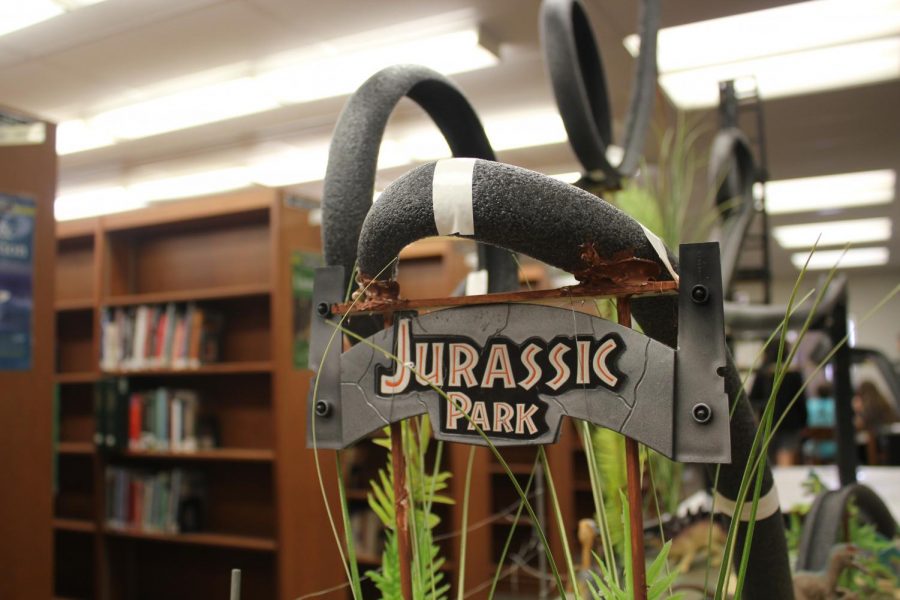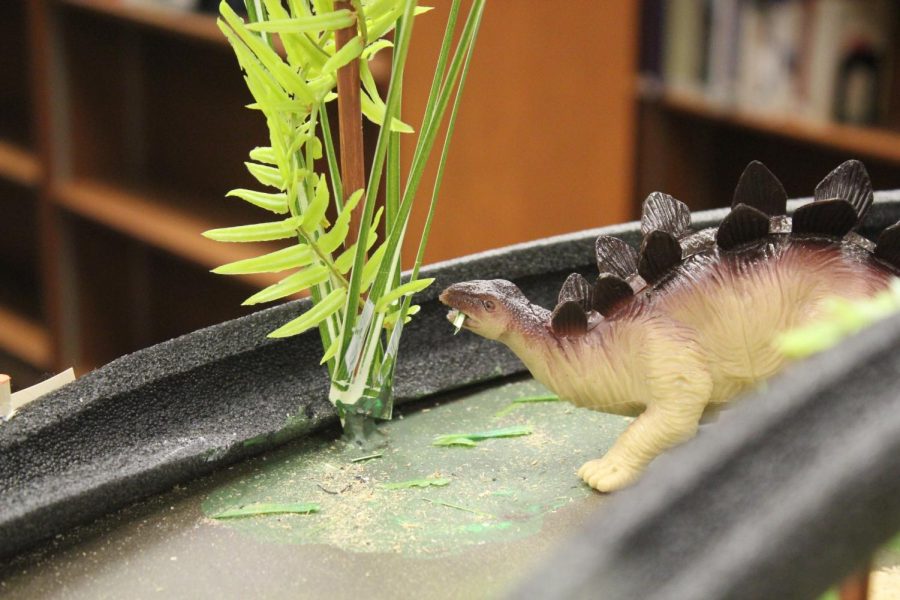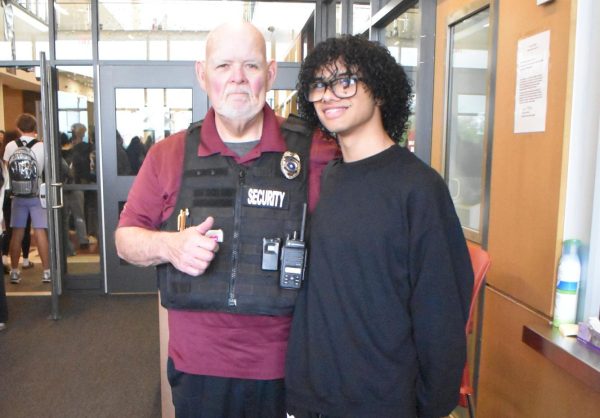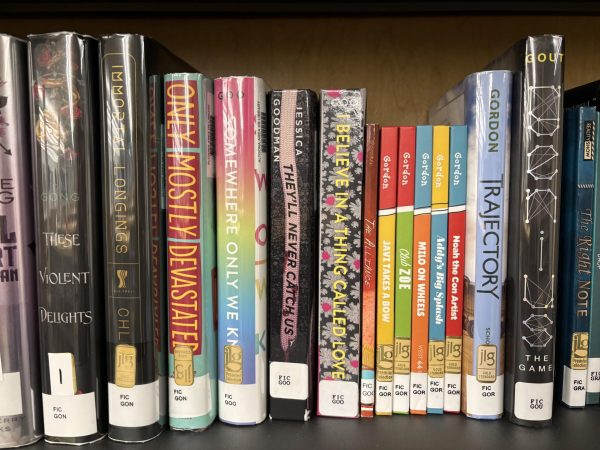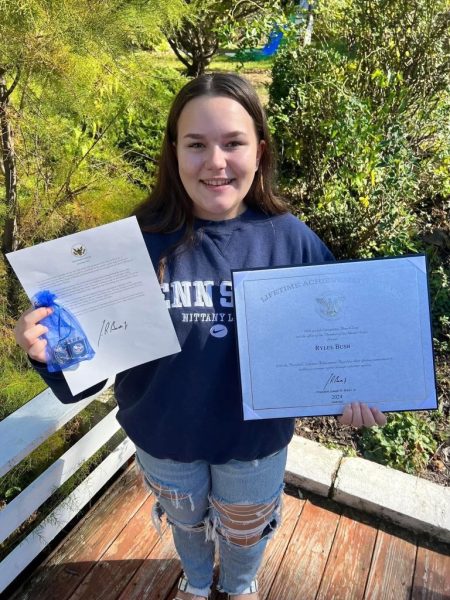Roller coasters speak loudly in library
Academic physics benchmarks display students’ creativity in library
The Jurassic Park sign hangs from the track of an academic physics roller coaster in the library. The coaster had many loops, curves, and inclines included, as students were graded on the features of their coaster.
What is it?
Academic physics classes created roller coasters to showcase in the high school library March 13 and 14. Students had to put together a roller coaster from scratch. This is the third marking period benchmark for the academic physics students that participated.
Benchmark: how it was graded
To grade this project, the teachers follow a four part grading system. Students must meet four deadlines throughout the months they work on the project.
These deadlines include filling out Google forms that provide information about what they are planning for their project. Along with the Google forms, all members of a group must keep a journal that details when they worked on the project, what specifically they did, and who was involved for the entire engineering design process.
The third part of the project is the grading of how the coaster actually performs and its structure. Students’ coasters must include a minimum of four features (hills, turns, loops, etc.), must be a maximum of six square feet, must have a track that is a minimum of 12 feet in length, and the coaster must be reliable (the marble must make it through the whole track five consecutive times).
The calculations is the final graded part of the project. The students must calculate all the gravitational potential energy that the marble has, determine its angle of descent, the speed of the marble and the acceleration. All of these calculations are then converted into real-world statistics.
Preparations
Students had approximately two months to complete the benchmark project, according to physics teacher Jason Geis.
“Students did not receive any classroom time, and the project was completed entirely outside of school. The project also serves as the replacement of the third marking period benchmark test,” Geis said.
Academic students were given the opportunity to work with anyone in any academic physics class, instead of just their classmates in their own period.
“We open the project up among all the Academic Physics students. We suggest to them to find people that work like they do. If they are someone who wants to finish the project early, then find people like themselves to work with. If they want to wait until closer to the deadline, choose people like that to work with. When building the roller coaster, I tell my students to make them sturdy. If they are not sturdy, then there is a higher chance of having issues with the track after transport,” physics teacher Jeremy Rupeka said.
Because this was such a time consuming project, students were cautioned as to who they chose to be in the group.
“I told them to make sure that they chose their partners wisely. We do not assign groups for the project and for this reason we do not adjust scores because ‘Sally didn’t do much.’ Our response, you shouldn’t have chosen to work with Sally. Also we told them to make sure they do not wait until the last minute as this is a big project worth a lot of points,” Geis said.
The symposium
The annual roller coaster symposium is held in the high school library. Physics teachers display the coasters from all periods of academic physics around the library. This year, the event was held March 13 and 14.
During the days of the symposium, the academic physics teachers take their students to the library for the whole period to test, do calculations and showcase their roller coasters.
Other teachers also may bring their students to the library to look at and vote for their favorite roller coaster.
In previous years, the academic physics teachers used a paper method for students to vote for their favorite roller coaster: students would write the name of the roller coaster that was their favorite on a piece of paper, and then put it in a bowl for the teachers to count later.
But, this year there is a QR code that is added to the coaster after it is finished so that students can vote electronically.
“There is a QR code voting system this year where the people voting simply need to scan the QR code with their device, open the form, and hit submit. The top 3 coasters, as long as they have met all of the requirements, can win prizes. First place each receives $25 Sheetz Gift Cards and homework passes, second place receives $20 GC each, and third place receives $15 GC each. All of the money that is used to support our project is funded by the AASD Foundation through a grant provided by Jim Kuhn from Reliance Bank,” physics teacher Deidra Dumm said.
The effects
Not only was this project a creative way to apply physics skills to real life situations, but it also allows students to utilize the engineering design process.
“The roller coaster is a way to model the conservation of energy which is a fundamental law that we study in physics this marking period. All energy in the roller coaster starts out as gravitational potential energy. As the marble gets lower in the roller coaster, the gravitational potential energy is converted to kinetic energy, the energy of motion. As long as the marble starts with enough energy at the beginning and the track doesn’t move too much, it will make it to the end of the ride. When students are building the roller coaster, we try to implement the engineering design process. We give students the task of designing a roller coaster. Then they have to come up with a design that they are thinking of and create their model. Along the way, they encounter issues with the marble either flying off the track or not having enough speed to reach the end of the ride. Then, they have to go back and make improvements and adjustments,” Rupeka said.
Students apply and develop many skills during the duration of this project.
“The skills that I would like to see the students develop are time management. We give them a long time to complete the project and it is up to them to find a balance to work on the project together. Another skill that I hope to see is how well students work within a group. The ultimate goal is that everyone equally contributes in a group project,” Rupeka said.
“The main skill I hope students get from this activity is problem solving skills. I also think it is good to get exposure to the engineering process which are skills that a sought after by future employers. Obviously I also hope they learn some of the physics concepts as well, but honestly the main thing is collaboration and problem solving,” Geis said.
“I hope that they gain the recognition that building a structure like this is not simply a thrown together project. Rather, there is truly an engineering design process that needs to be completed to see true success. I also hope that they can utilize the physics concepts taught in class to understand how the coaster works and what is actually required to keep the marble on the track,” Dumm said.
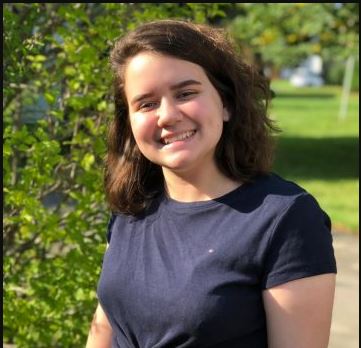
My name is Nina Cipriani, and I am a senior at AAHS. I enjoy hanging out with my friends and watching Netflix when school and work are not occupying all...



